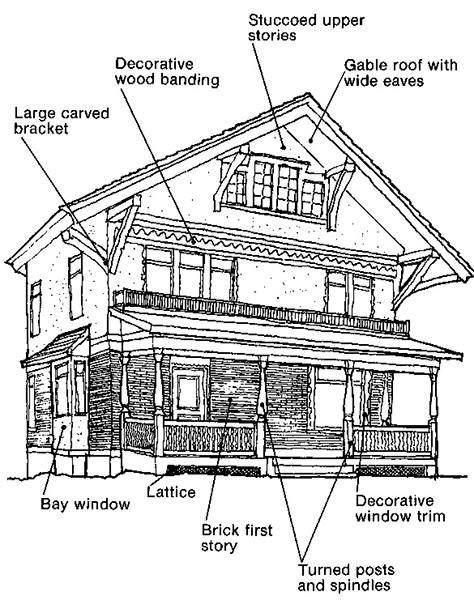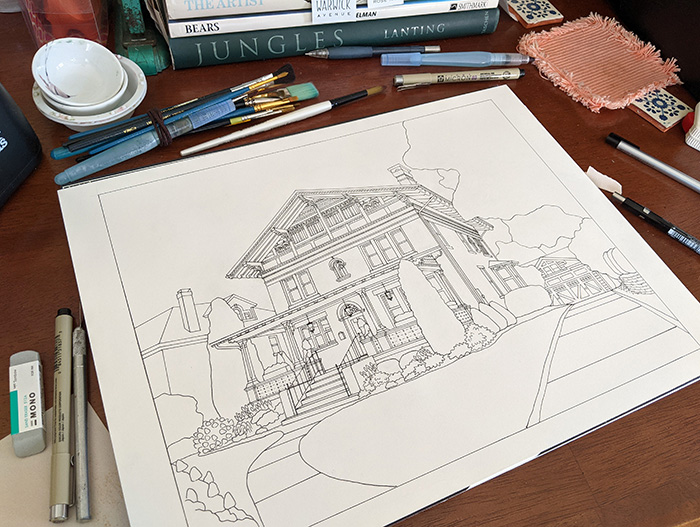The architecture of Cincinnati never ceases to amaze me. In addition to the Tudor and Bungalow style, one of my absolute favorites is the Swiss Chalet. So when my friend and neighbor, Julie, asked me to do a house portrait for her I was so excited!
The Swiss Chalet style experienced a revival in North America from 1900 to 1925. Architect Andrew Jackson Downing was credited for the resurgence of the style after publication of his book, The Architecture of Country Houses (1850). The style was also popularized by the publications of William S.B. Dana’s, The Swiss Chalet Book (1913), and Henry Saylor’s Architectural Styles for County Houses: The Swiss Chalet Type (1912).
Here are a few of my favorite images from Dana's, The Swiss Chalet Book.
The Swiss Chalet style was not widespread in the United States, but we are lucky that Cincinnati was one of the rare locations where it enjoyed popularity. Cincinnati architect, Lucien Plympton, is credited with bringing the Swiss chalet style to Cincinnati during the Arts & Crafts era of the early twentieth century.
The City of Cincinnati's website offers this diagram to show some of the characteristics of the style:
The City of Cincinnati's website offers this diagram to show some of the characteristics of the style:
In my pencil sketch below, you can see my friend Julie's house displays the gabled roof with wide eaves, the decorative wood banding, large carved brackets, and a bay window. The house had so much intricate detail that I ended up having to enlarge some of the fancy woodwork in my sketch...otherwise it was simply too small to draw. When I think about whoever built this house and all the attention to detail, it blows my mind!
Once the pencil sketch was finished I used carbon paper to transfer the drawing to heavy watercolor paper. I was not very happy with the transfer. It was super light and left a lot of fuzzy carbon everywhere that didn't erase well. I wish I had taken a picture of it at that stage. I ended up basically having to re-draw it entirely in pencil again. I figure by the time I am done with the portrait I have easily gone over each line about 5-7 times. Below you can see the inked-in drawing.
Adding the watercolor is my favorite part of the process. Below you can see the house with just two colors. I often like how it looks at this stage and want to stop. But of course, I could never stop here because it is so fun to add the shadows that make it look three dimensional.
Here is a video of the process of coloring the sketch from start to finish. Turn on your volume! (Music by Lesfm from Pixabay)
My desk is always a complete and utter mess at the end.
I was watching a video recently about sketchers who are documenting climate change through their drawings. The moderator asked each participant what they thought about the idea that "Attention equals love." Each artist agreed and described their experience of love and loss. I have come across this concept before in various ways and every time I hear it, it strikes me deeply as the truth. The moderator credited it to John Muir Laws and when I googled it I came across this quote:
"Attention is the most basic form of love.
Through it, we bless and are blessed."
— John Tarrant
Through it, we bless and are blessed."
— John Tarrant
I whole-heartedly agree and have long felt that where we put our attention is one of our greatest powers. We don't realize it, but our focused attention is like an ultra powerful beam of love that we can direct onto anything we choose. When we consciously give our entire attention to some one or some thing and are fully present, it is a tremendously powerful gift.
To bring it back to the topic at hand, when I look at the Swiss chalet style of architecture, I see these houses as love made manifest. The time and attention that went into crafting all the detail is none other than love in physical form. That is why it feels so good to create. And that is also what happens when we draw something. To drink in all the details and then try to re-create the lines is the deepest form of honoring your subject. The line of the pencil hugs every curve and nuance. If I am truly giving it my full attention, for a moment I become my subject and my subject becomes me and time disappears. To lose oneself in love is one of life's greatest pleasures.
“Attention is the beginning of devotion.”
― Mary Oliver


















1 comment:
I so enjoyed the description of the process in making this work of art and the connection you discuss between love and attention! I think the architect would be honored. Candace
Post a Comment